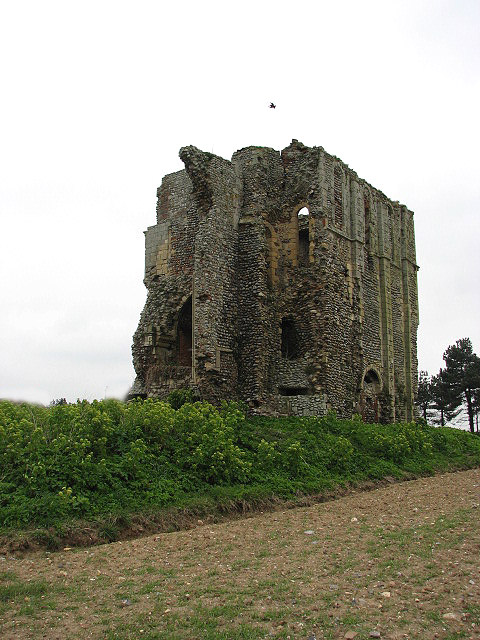Bromholm Priory on:
[Wikipedia]
[Google]
[Amazon]

 Bromholm Priory was a
Bromholm Priory was a
A Short History of Bromholm Priory
published 1911.

Cluniac
Cluny Abbey (; , formerly also ''Cluni'' or ''Clugny''; ) is a former Order of Saint Benedict, Benedictine monastery in Cluny, Saône-et-Loire, France. It was dedicated to Saint Peter, Saints Peter and Saint Paul, Paul.
The abbey was constructed ...
priory
A priory is a monastery of men or women under religious vows that is headed by a prior or prioress. They were created by the Catholic Church. Priories may be monastic houses of monks or nuns (such as the Benedictines, the Cistercians, or t ...
, situated in a coastal location near the village of Bacton, Norfolk
Norfolk ( ) is a Ceremonial counties of England, ceremonial county in England, located in East Anglia and officially part of the East of England region. It borders Lincolnshire and The Wash to the north-west, the North Sea to the north and eas ...
, England
England is a Countries of the United Kingdom, country that is part of the United Kingdom. It is located on the island of Great Britain, of which it covers about 62%, and List of islands of England, more than 100 smaller adjacent islands. It ...
History
Bromholm Priory, also known as Bacton Abbey, was founded in 1113 by William de Glanville, Lord of Bacton, and was originally subordinate toCastle Acre Priory
Castle Acre Priory was a Cluniac priory in the village of Castle Acre, Norfolk, England, dedicated to St Mary, St Peter, and St Paul. It is thought to have been founded in 1089 by William de Warenne, 2nd Earl of Surrey (the son of the ...
until 1195 when it was exempted by Pope Celestine III. King Henry III visited the priory in 1223 to take the holy waters and dedicate to the relics; lands nearby at Cawston, Beeston, Burgh and Aylsham were controlled by the all-powerful Chief Justiciar Hubert de Burgh
Hubert de Burgh, Earl of Kent ( , ; – before 5 May 1243) was an English nobleman who served as Chief Justiciar of England (1215–1232) and Justiciar of Ireland (1232) during the reigns of King John and his son and successor King Henry I ...
until his death on 12 May 1243. From this priory we have the Bromholm Psalter dated to the early fourteenth century. The priory was suppressed in 1536. All that now remains are the ruins of the gatehouse, Chapter House, and the northern transept of the Priory Church.
It was an important object of pilgrimage as it claimed to possess a piece of the True Cross
According to Christian tradition, the True Cross is the real instrument of Jesus' crucifixion, cross on which Jesus of Nazareth was Crucifixion of Jesus, crucified.
It is related by numerous historical accounts and Christian mythology, legends ...
, mentioned as the 'holy cross of Bromeholme' in Chaucer's ''The Reeve's Tale
"The Reeve's Tale" is the third story told in Geoffrey Chaucer's ''The Canterbury Tales''. The reeve, named Oswald in the text, is the manager of a large estate who reaped incredible profits for his master and himself. He is described in the ...
'' and William Langland
William Langland (; ; ) is the presumed author of a work of Middle English alliterative verse generally known as ''Piers Plowman'', an allegory with a complex variety of religious themes. The poem translated the language and concepts of the cl ...
's ''Vision of Piers Plowman
''Piers Plowman'' (written 1370–86; possibly ) or ''Visio Willelmi de Petro Ploughman'' (''William's Vision of Piers Plowman'') is a Middle English allegorical narrative poem by William Langland. It is written in un-rhymed, alliterative ...
''. This piece of the True Cross was brought from Constantinople, after the Fourth Crusade
The Fourth Crusade (1202–1204) was a Latin Christian armed expedition called by Pope Innocent III. The stated intent of the expedition was to recapture the Muslim-controlled city of Jerusalem, by first defeating the powerful Egyptian Ayyubid S ...
, by an anonymous English Monk.
It was a benefice of the Paston family and is featured in their letters
Letter, letters, or literature may refer to:
Characters typeface
* Letter (alphabet), a character representing one or more of the sounds used in speech or none in the case of a silent letter; any of the symbols of an alphabet
* Letterform, the g ...
.
In 1940 the base of the central tower of the priory church was modified to act as a pillbox in case of German invasion. A similarly disguised gun emplacement can be seen created in the medieval masonry of Pevensey Castle
Pevensey Castle is a medieval castle and former Roman Saxon Shore fort at Pevensey in the English county of East Sussex. The site is a scheduled monument in the care of English Heritage and is open to visitors. Built around 290 AD and known to ...
in East Sussex, also close to the sea.
Considerable graphic visualisations of what the priory and its lands looked like throughout its history were produced in 2019 and 2020 by members of the Paston Portal.Paston Portal URL: https://www.thisispaston.co.uk/bromholm01.html Date accessed: 14 February 2022
A Short History of Bromholm Priory
published 1911.
References
* British History Online (2003-5). ''Houses of Cluniac monks — The priory of Bromholm''. Retrieved 7 December 2005. Cockerell, Sydney Carlyle, Sir. Two East Anglian psalters at the Bodleian library. Oxford: Printed for the Roxburghe Club by J. Johnson, 1926. (Facsimile of Bolmholm Psalter) Cluniac monasteries in England Monasteries in Norfolk 1113 establishments in England 1536 disestablishments in England Grade I listed buildings in Norfolk Christian monasteries established in the 1110s {{UK-Christian-monastery-stub